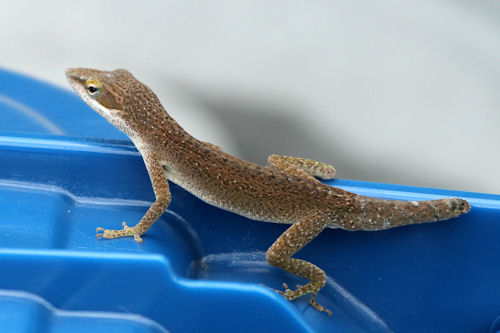Journal of Functional Ecology
These scientists wanted to find out how age and food availability affects the correlation between risk taking and morphological defense through tail autotomy in brown anole lizards. The article is centered around the concept of "trait compensation" which is where individuals will balance the costs of one trait with the benefit of another trait. In this case it is between traits possessed by Anolis sagrei, bolder individuals will seek new territory and therefore expose themselves to risks of more predators while careful/shy individuals will not explore as much and will not be at a higher risk. These risk taking lizards will compensate for this behavior through morphological defense (tail autotomy).
The scientists Chi-Yun Kuo, Duncan Irschick, and Simon Lailvaux caught 59 juvenile A. sagrei in New Orleans City Park and raised them until sexually mature for 3 months to minimize previous predatory experiences. They then performed behavioral trails on 32 males to determine their degree of risky exploratory behavior. Authors recorded time it took for them to explore the new environment, percent of time in the new environment, and percent of time spent on perches. The perches would give them more vulnerability to predators. They then basically ripped their tails off and measured the amount of force that it took for each individual to break it off. The larger the force the lower the propensity for tail autotomy. They also measured the distance and width of the area where the break occurred. With all this data they determined that bolder individuals would readily loose their tails over shy individuals. Trait compensation was prevalent only among individuals raised with abundant food, when food was scarce the correlation lost validity. The authors propose that boldness and propensity for tail autotomy could be genetically linked or regulated by the same hormones. The availability of food became a major factor in this study, showing that compensating for risk taking behavior through tail loss is only beneficial when lizards can find enough food to regenerate the tail quickly.
It is interesting to learn some of the reasons for tail loss. I love catching green anoles and only when I was younger their tails would come off (was not as skilled as now with handling them). I have always wondered at what point do they just say screw it, break their tail, and hope for the best. This article outlines some of the reasoning behind their behavior. The loss of their tail definitely hinders their ability to balance and escape predators as well as catch prey, so to understand some of the reasoning behind this is very useful to our class.
http://onlinelibrary.wiley.com/doi/10.1111/1365-2435.12324/full

2 comments:
Your findings are really interesting, and it makes logically sense that bolder individuals would readily loose their tails over shy individuals. Did it say in the research if this trait of "boldness" is in enduring trait so linking it to genetic or if it's more situation factor -relating back to food supply?
Fascinating article - thanks for sharing this!
Animal 'personalities' (also known as 'behavioral syndromes') are usually defined as showing consistency within an individual. In some species, behaviors like bold vs. shy have been shown to have a genetic component.
Post a Comment